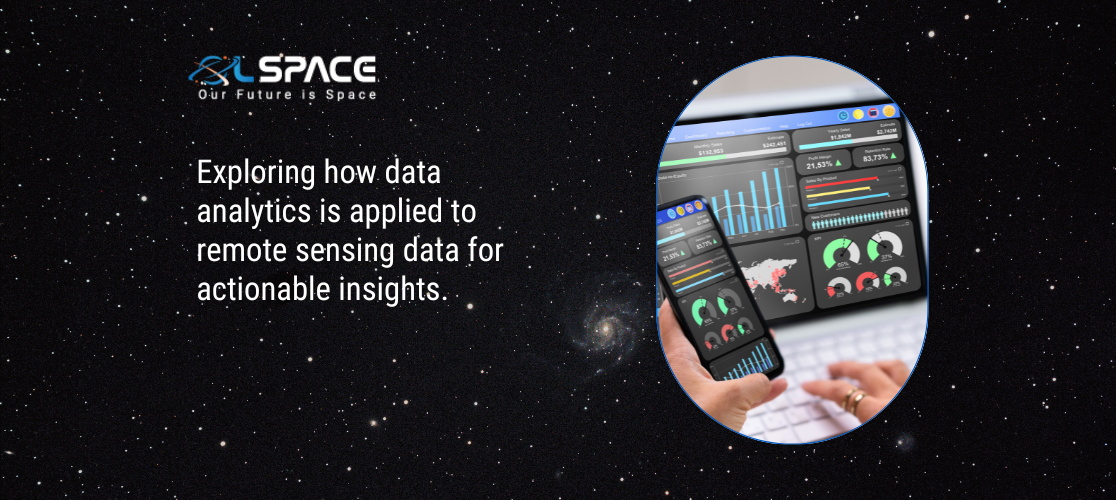18 January 2024
Exploring how data analytics is applied to remote sensing data for actionable insights.

In the realm of Earth observation, remote sensing has become a critical tool for collecting vast amounts of data about our planet. However, the true value of remote sensing data emerges when coupled with advanced data analytics techniques. This article explores the application of data analytics to remote sensing data, unraveling how this synergy provides actionable insights with far-reaching implications for various industries and fields.
1. Image Classification and Land Cover Mapping:
Algorithmic Recognition: Data analytics algorithms analyze satellite images to classify and identify land cover types, providing detailed maps of vegetation, urban areas, water bodies, and more.
Change Detection: Continuous monitoring enables the detection of changes over time, such as urban expansion, deforestation, or shifts in agricultural patterns.
2. Environmental Monitoring and Climate Studies:
Temperature and Precipitation Analysis: Remote sensing data, when subjected to analytics, contributes to climate studies by analyzing temperature patterns, precipitation levels, and identifying climate change indicators.
Vegetation Health Assessment: Analyzing spectral data allows for the assessment of vegetation health, helping monitor ecosystems and detect early signs of stress or degradation.
3. Disaster Response and Risk Assessment:
Pre- and Post-Event Analysis: Rapid analysis of remote sensing data aids in assessing the impact of natural disasters such as floods, wildfires, or earthquakes, enabling timely and informed disaster response.
Vulnerability Mapping: Analytics help identify areas at risk, allowing for proactive risk assessment and planning for potential disasters.
4. Precision Agriculture:
Crop Health Monitoring: Remote sensing data analytics provide farmers with insights into crop health, nutrient levels, and potential pest infestations, enabling precision agriculture practices.
Yield Prediction: By analyzing historical and real-time data, predictive analytics can estimate crop yields, assisting in resource allocation and decision-making.
5. Urban Planning and Infrastructure Development:
Population Density Analysis: Remote sensing analytics contribute to urban planning by analyzing population density, helping plan infrastructure development and public services.
Land Use Planning: Land use patterns can be identified and analyzed, aiding in the planning and zoning of urban areas for optimized development.
6. Water Resource Management:
Water Quality Monitoring: Remote sensing data analytics assess water quality parameters, identifying pollutants, algal blooms, and changes in water composition.
Reservoir and Aquifer Monitoring: Continuous monitoring helps track water levels in reservoirs and aquifers, supporting efficient water resource management.
7. Biodiversity Conservation:
Habitat Monitoring: Analytics on remote sensing data contribute to monitoring biodiversity by assessing changes in habitats, tracking migration patterns, and identifying areas of ecological significance.
Illegal Logging and Poaching Detection: Remote sensing analytics assist in detecting and combatting illegal activities such as logging and poaching by monitoring protected areas.
8. Infrastructure Inspection and Asset Management:
Pipeline and Power Line Monitoring: Aerial analytics inspect and monitor the condition of critical infrastructure such as pipelines and power lines, facilitating preventive maintenance.
Railway and Road Network Analysis: Remote sensing analytics contribute to the analysis of transportation networks, aiding in route optimization and infrastructure planning.
9. Archaeological and Cultural Heritage Preservation:
Site Detection and Documentation: Remote sensing analytics assist archaeologists in identifying potential archaeological sites and documenting cultural heritage from aerial perspectives.
Monitoring for Conservation: Ongoing monitoring supports the conservation of historical sites by identifying threats or changes in their surroundings.
10. Satellite Constellation Management:
Orbit and Satellite Health Monitoring: Analytics ensure the health and optimal positioning of satellite constellations, minimizing collision risks and maximizing data acquisition efficiency.
Data Fusion for Enhanced Insights: Combining data from multiple satellites using analytics enhances the richness and accuracy of insights, providing a comprehensive view of the Earth’s surface.
Conclusion: Turning Remote Sensing Data into Actionable Intelligence
The application of data analytics to remote sensing data unlocks a wealth of actionable intelligence across diverse fields. As technology continues to advance, the synergy between remote sensing and analytics is poised to play a pivotal role in addressing global challenges, from environmental conservation to disaster response and sustainable resource management. By harnessing the power of analytics, we not only gain a deeper understanding of our planet but also pave the way for informed decision-making that can shape a more sustainable and resilient future.
